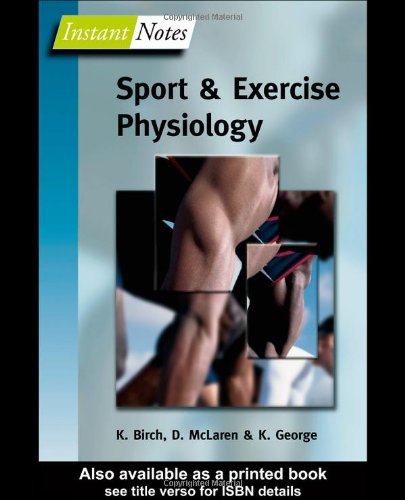

Most ebook files are in PDF format, so you can easily read them using various software such as Foxit Reader or directly on the Google Chrome browser.
Some ebook files are released by publishers in other formats such as .awz, .mobi, .epub, .fb2, etc. You may need to install specific software to read these formats on mobile/PC, such as Calibre.
Please read the tutorial at this link: https://ebookbell.com/faq
We offer FREE conversion to the popular formats you request; however, this may take some time. Therefore, right after payment, please email us, and we will try to provide the service as quickly as possible.
For some exceptional file formats or broken links (if any), please refrain from opening any disputes. Instead, email us first, and we will try to assist within a maximum of 6 hours.
EbookBell Team

4.7
66 reviews 
ISBN 10: 1859962491
ISBN 13: 978-1859962497
Author: Karen Birch, Keith George, Don McLaren
Instant Notes in Sport and Exercise Physiology looks at the key topics in exercise physiology and examines how each of the physiological systems responds to acute and chronic exercise. As well as reviewing special topics such as nutrition, altitude, temperature, and ergogenic acids, it assesses the importance of exercise to health and quality of life and considers the importance of exercise to adults, children and the elderly.
Part A – Fundamentals of Exercise Physiology
Chapter A1 – Fundamentals of Exercise Physiology
Chapter A2 – Force, Work and Power
Chapter A3 – Work and Power Performed on the Cycle Ergometer and Treadmill
Chapter A4 – Estimation and Measurement of Energy Expenditure
Part B – Bioenergetics for Movement
Chapter B1 – Energy Sources and Exercise
Chapter B2 – Rates of Energy Production
Chapter B3 – Energy Stores
Chapter B4 – Control of Energy Sources
Chapter B5 – Energy for Exercise of Varying Intensities
Chapter B6 – Responses to Training
Part C – Skeletal Muscle Contraction and Control
Chapter C1 – Muscle Structure
Chapter C2 – Motor–Neural Control of Contraction and Relaxation
Chapter C3 – Force–Velocity and Length–Tension Characteristics
Chapter C4 – Fiber Types
Chapter C5 – Adaptations to Training
Part D – Pulmonary Adaptations to Exercise
Chapter D1 – Pulmonary Structure and Volumes
Chapter D2 – Pulmonary Function and Control
Chapter D3 – Pulmonary Responses to Exercise
Chapter D4 – Pulmonary Responses to Training
Part E – Cardiovascular Adaptations to Exercise
Chapter E1 – Cardiovascular Structure
Chapter E2 – Cardiovascular Function and Control
Chapter E3 – Cardiovascular Responses to Exercise
Chapter E4 – Cardiovascular Responses to Training
Part F – Integrated Neural and Hormonal Control of Exercise
Chapter F1 – The Neural System
Chapter F2 – The Endocrine System
Part G – Nutrition and Ergogenic Aids for Sports Performance
Chapter G1 – Fatigue and Ergogenic Aids
Chapter G2 – Macronutrients
Chapter G3 – Fluids
Chapter G4 – Nutritional Ergogenic Aids
Part H – Training for Performance
Chapter H1 – Training Principles
Chapter H2 – Training for Aerobic Power
Chapter H3 – Training for Anaerobic Power
Chapter H4 – Training for Strength and Power
Chapter H5 – Training for Flexibility
Part I – Exercise and Environmental Stress
Chapter I1 – Thermoregulation
Chapter I2 – Exercise in Hot and Humid Environments
Chapter I3 – Exercise in Cold Environments
Chapter I4 – Exercise at Altitude
Chapter I5 – Exercise Underwater
Chapter I6 – Jet Lag and Exercise
Part J – Energy Balance, Body Composition and Health
Chapter J1 – Energy Balance
Chapter J2 – Body Composition
Chapter J3 – Changing Body Mass and Body Fat
Part K – Disease, Exercise and Health
Chapter K1 – Exercise, Fitness and Health
Chapter K2 – Physiological Benefits of Exercise
Chapter K3 – Exercise and Disease
Part L – Exercise Prescription for Health
Chapter L1 – Screening and Exercise Testing
Chapter L2 – Guidelines for Exercise Prescription
Chapter L3 – Special Populations
instant notes in sport and exercise physiology
exercise notes
exercise physiology lecture
exercise science notes
exercise physiology 101
physiology and sports notes
Tags: Karen Birch, Keith George, Don McLaren, Instant Notes, Sport, Exercise Physiology